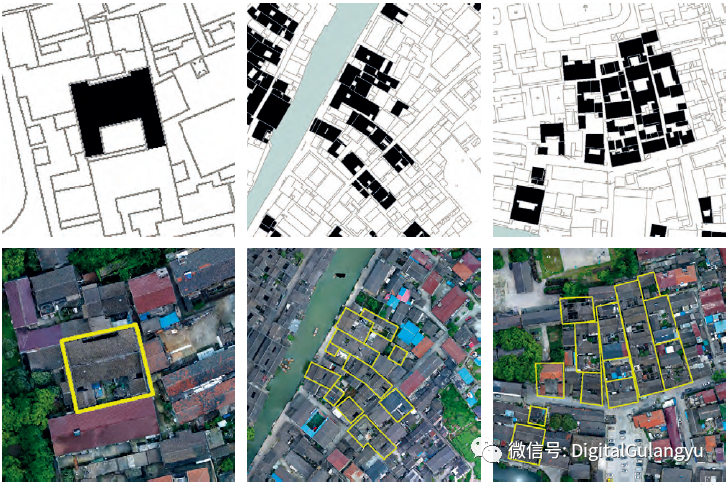Historical buildings intelligent identification Zhou Jian Ye Zhen, official account: Architectural Heritage journal Zhou Jian, Ye Zhen, Yu Wenbin, Song Junfeng, Li Yan Ning, feasibility study of intelligent recognition of historical buildings — using the orthophoto and digital image detection technology in Jiangnan Water Town experiment, citing Zhou Jian, Ye Zhen, Yu Wenbin, The feasibility study of intelligent recognition of historical buildings — the experiment of ancient towns in Jiangnan Water Town using orthophoto and digital image detection technology [J]
. 
Architectural heritage, 2020, (03): 102-110
.
Research purpose to design an intelligent recognition tool of historical buildings based on spatial data
.
The identification of historical buildings, historical blocks and historical villages and towns are all discovered by experts and surveyed by experts on the spot
.
This kind of screening method needs “manual discovery” first, and “manual identification” second
.
The workload of on-site survey is heavy, the time of internal and external work is long, and there are inevitable omissions
.
In recent years, with the rapid development of information technology, oblique photography and digital image recognition technology, people’s ability to collect, store and analyze spatial data has been greatly improved
.
It is a new field to apply these new technologies to the research and protection of urban and rural cultural heritage (material), including the census, evaluation and monitoring management of material heritage
.
Research methods based on the spatial orthophoto data collected by UAV, with the help of morphological and typological principles, the intelligent recognition model is established by using image recognition technology
.
Through model operation, the historical building intelligent recognition and spatial positioning are carried out on the orthophoto, and the potential historical building points are marked on the orthophoto
.
Professor Zhou Jian, School of architecture and urban planning, Tongji University
.
Research direction: cultural heritage protection, urban renewal and urban design, residential planning and design
.
Professor Zhou Jian has been engaged in the teaching, research and practice of urban and rural planning for more than 30 years
.
He has completed more than 200 planning and design projects and accumulated rich practical experience
.
Since 1999, it has won 21 awards in all previous national excellent urban and rural planning and design awards, including 5 first-class awards, 1 Gold Award for national excellent engineering survey and design, 2 international awards for cultural heritage protection, and many honorary titles such as the knight of French literature and art, Shanghai May 1st Labor Medal, etc
.
Reference [1] Wu Weijia, Wu Liangyong, Shi Xiaodong, et al
.
Human settlements and high quality development [J]
.
Urban planning, 2020,44 (01): 99-104
.
[2] Guo Chenda, Zhou Jian
.
Research on spatial characteristics of traditional villages from the perspective of cultural gene based on “urban man” Theory — Taking Zhangguying village as an example [J]
.
Shanghai urban planning, 2020,44 (01): 88-92
.
[3] Zhou Jian, Ye Zhen, Yu Wenbin, [J]
.
Architectural heritage, 2020, (03): 102-110
.
[4] Guo Chenda, Zhou Jian
.
The influence of clan thought on the formation of spatial characteristics of Traditional Villages: a case study of zhoujiadawu in Zhonggang village [J]
.
Housing technology, 2019, 39 (05): 49-52
.
[5] Zhou Jian
.
Thoughts on the protection of historical spatial pattern of famous historical and cultural cities [n]
.
China Construction daily
.
[6] Ye Jianwei, Zhou Jian, Feng Yan
.
SOHs methodology: a case study of New South Wales [J]
.
Urban development research, 2016, 23 (02): 13-18
.
[7] Zhou Jian
.
Research on urban heritage and its protection system — Reflections on several issues of Shanghai historical and cultural city protection planning [J]
.
Shanghai urban planning, 2016, (03): 73-80
.
[8] Zhou Jian, Zhong Xiaohua
.
Discussion on rural heritage protection path from the perspective of development — Dong village field work case [J]
.
Journal of urban planning, 2015, (01): 54-60
.
[9] Kou huaiyun, Zhou Jian
.
Thoughts on the conservation planning of ethnic villages from the perspective of cultural space [J]
.
Shanghai urban planning, 2014, (03): 44-49
.
[10] Ma Rongjun, Zhou Jian
.
Protection and vitality promotion of daily urban heritage: Inspiration from the management of old commercial street in Paris [J]
.
Urban architecture, 2013, (05): 31-34
.
[11] Zhou Jian
.
Protection of “living” Cultural Heritage [J]
.
Small town construction, 2012, (10): 44-46
.
[12] Zhong Xiaohua, Zhou Jian
.
The evolution of the role of heritage in urban renewal: interpreting three cases in the process of “old reform” in Shanghai central urban area [J]
.
urban and rural planning, 2012, (01): 113-120.[13] Zhou Jian, Lu Xiaoyu
.
The protection methods of historic city, [J]., China’s famous city, 2009, (08): 32-35.[14] Pan Bin, Zhang Jiantao, Zhou Jian
.
Verification of Kevin Lynch’s “theory of form core value standard” — a case study of Jiangwan Wujiaochang area in Shanghai [J]
.
International urban planning, 2008, (03): 115-119
.
[15] Wu Zhiqiang, Chen Xiaolong, Qian Feng, et al
.
Ecological renewal of historic buildings: Wenyuan building, Tongji University [Z]
.
Beijing, China, 2007
.
[16] Wu Zhiqiang, Chen Xiaolong, Qian Feng, Wenyuan building, Tongji University: ecological renewal of historic buildings [J]
.
Construction technology, 2007, (06): 30-31
.
[17] Zhou Jian
.
Relationship between urban construction and cultural heritage protection [Z]
.
Yuxi, Yunnan, China, 2006
.
[18] Yan Hong, Su Guangrong, Zhou Jian, etc
.
How to protect Chinese Cultural Heritage [Z]
.
Yuxi, Yunnan, China, 2006
.
[19] Zhou Jian, Zhang Kai
.
Architectural classification and protection measures in historical and cultural heritage protection planning [J]
.
Urban planning, 2001, (01): 38-42.
.


